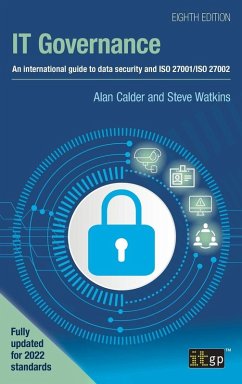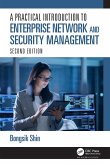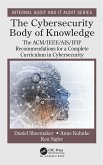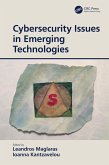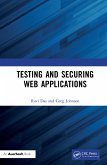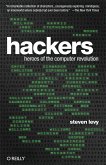Alan Calder, Steve Watkins
IT Governance
An international guide to data security and ISO 27001/ISO 27002, Eighth edition
Alan Calder, Steve Watkins
IT Governance
An international guide to data security and ISO 27001/ISO 27002, Eighth edition
- Gebundenes Buch
- Merkliste
- Auf die Merkliste
- Bewerten Bewerten
- Teilen
- Produkt teilen
- Produkterinnerung
- Produkterinnerung
- Weitere 7 Ausgaben:
- Broschiertes Buch
- Broschiertes Buch
- eBook, ePUB
- eBook, ePUB
- eBook, ePUB
- eBook, ePUB
- eBook, PDF
This book provides expert information security management and governance guidance based on ISO 27001:2022 and ISO 27002:2022.
Andere Kunden interessierten sich auch für
![A Practical Introduction to Enterprise Network and Security Management A Practical Introduction to Enterprise Network and Security Management]() Bongsik ShinA Practical Introduction to Enterprise Network and Security Management130,99 €
Bongsik ShinA Practical Introduction to Enterprise Network and Security Management130,99 €![A Practical Introduction to Enterprise Network and Security Management A Practical Introduction to Enterprise Network and Security Management]() Bongsik ShinA Practical Introduction to Enterprise Network and Security Management61,99 €
Bongsik ShinA Practical Introduction to Enterprise Network and Security Management61,99 €![The Cybersecurity Body of Knowledge The Cybersecurity Body of Knowledge]() Daniel ShoemakerThe Cybersecurity Body of Knowledge150,99 €
Daniel ShoemakerThe Cybersecurity Body of Knowledge150,99 €![Cybersecurity Issues in Emerging Technologies Cybersecurity Issues in Emerging Technologies]() Cybersecurity Issues in Emerging Technologies111,99 €
Cybersecurity Issues in Emerging Technologies111,99 €![Testing and Securing Web Applications Testing and Securing Web Applications]() Ravi DasTesting and Securing Web Applications169,99 €
Ravi DasTesting and Securing Web Applications169,99 €![Hackers. 25th Anniversary Edition Hackers. 25th Anniversary Edition]() Steven LevyHackers. 25th Anniversary Edition23,77 €
Steven LevyHackers. 25th Anniversary Edition23,77 €![How to Hack Like a Legend How to Hack Like a Legend]() Sparc FLOWHow to Hack Like a Legend18,99 €
Sparc FLOWHow to Hack Like a Legend18,99 €-
-
-
This book provides expert information security management and governance guidance based on ISO 27001:2022 and ISO 27002:2022.
Hinweis: Dieser Artikel kann nur an eine deutsche Lieferadresse ausgeliefert werden.
Hinweis: Dieser Artikel kann nur an eine deutsche Lieferadresse ausgeliefert werden.
Produktdetails
- Produktdetails
- Verlag: It Governance Publishing Ltd
- 8th edition
- Seitenzahl: 506
- Erscheinungstermin: 17. Oktober 2024
- Englisch
- Abmessung: 229mm x 152mm x 38mm
- Gewicht: 848g
- ISBN-13: 9781787785540
- ISBN-10: 1787785548
- Artikelnr.: 72129113
- Herstellerkennzeichnung
- Libri GmbH
- Europaallee 1
- 36244 Bad Hersfeld
- gpsr@libri.de
- Verlag: It Governance Publishing Ltd
- 8th edition
- Seitenzahl: 506
- Erscheinungstermin: 17. Oktober 2024
- Englisch
- Abmessung: 229mm x 152mm x 38mm
- Gewicht: 848g
- ISBN-13: 9781787785540
- ISBN-10: 1787785548
- Artikelnr.: 72129113
- Herstellerkennzeichnung
- Libri GmbH
- Europaallee 1
- 36244 Bad Hersfeld
- gpsr@libri.de
Alan Calder founded IT Governance Ltd in 2002 and began working full-time for the company in 2007. He is now Group CEO of GRC International Group PLC, the AIM-listed company that owns IT Governance Ltd. Before this, Alan had a number of roles including CEO of Business Link London City Partners (a government agency focused on helping growing businesses to develop) from 1995 to 1998, CEO of Focus Central London (a training and enterprise council) from 1998 to 2001, and CEO of Wide Learning (a supplier of e-learning) from 2001 to 2003 and the Outsourced Training Company (2005). He was also chairman of CEME (a public-private sector skills partnership) from 2006 to 2011. Alan is an acknowledged international cyber security guru and a leading author on information security and IT governance issues. He has been involved in the development of a wide range of information security management training courses that have been accredited by ITBITGQ (International Board for IT Governance Qualifications). Alan has consulted for clients in the UK and abroad, and is a regular media commentator and speaker.
Chapter
01: Why is information security necessary?; Chapter
02: The UK combined code, the FRC risk guidance and Sarbanes
Oxley; Chapter
03: ISO27001; Chapter
04: Organizing information security; Chapter
05: Information security policy and scope; Chapter
06: The risk assessment and Statement of Applicability; Chapter
07: Mobile devices; Chapter
08: Human resources security; Chapter
09: Asset management; Chapter
10: Media handling; Chapter
11: Access control; Chapter
12: User access management; Chapter
13: System and application access control; Chapter
14: Cryptography; Chapter
15: Physical and environmental security; Chapter
16: Equipment security; Chapter
17: Operations security; Chapter
18: Controls against malicious software (malware); Chapter
19: Communications management; Chapter
20: Exchanges of information; Chapter
21: System acquisition, development and maintenance; Chapter
22: Development and support processes; Chapter
23: Supplier relationships; Chapter
24: Monitoring and information security incident management; Chapter
25: Business and information security continuity management; Chapter
26: Compliance; Chapter
27: The ISO27001 audit
01: Why is information security necessary?; Chapter
02: The UK combined code, the FRC risk guidance and Sarbanes
Oxley; Chapter
03: ISO27001; Chapter
04: Organizing information security; Chapter
05: Information security policy and scope; Chapter
06: The risk assessment and Statement of Applicability; Chapter
07: Mobile devices; Chapter
08: Human resources security; Chapter
09: Asset management; Chapter
10: Media handling; Chapter
11: Access control; Chapter
12: User access management; Chapter
13: System and application access control; Chapter
14: Cryptography; Chapter
15: Physical and environmental security; Chapter
16: Equipment security; Chapter
17: Operations security; Chapter
18: Controls against malicious software (malware); Chapter
19: Communications management; Chapter
20: Exchanges of information; Chapter
21: System acquisition, development and maintenance; Chapter
22: Development and support processes; Chapter
23: Supplier relationships; Chapter
24: Monitoring and information security incident management; Chapter
25: Business and information security continuity management; Chapter
26: Compliance; Chapter
27: The ISO27001 audit
Chapter
01: Why is information security necessary?; Chapter
02: The UK combined code, the FRC risk guidance and Sarbanes
Oxley; Chapter
03: ISO27001; Chapter
04: Organizing information security; Chapter
05: Information security policy and scope; Chapter
06: The risk assessment and Statement of Applicability; Chapter
07: Mobile devices; Chapter
08: Human resources security; Chapter
09: Asset management; Chapter
10: Media handling; Chapter
11: Access control; Chapter
12: User access management; Chapter
13: System and application access control; Chapter
14: Cryptography; Chapter
15: Physical and environmental security; Chapter
16: Equipment security; Chapter
17: Operations security; Chapter
18: Controls against malicious software (malware); Chapter
19: Communications management; Chapter
20: Exchanges of information; Chapter
21: System acquisition, development and maintenance; Chapter
22: Development and support processes; Chapter
23: Supplier relationships; Chapter
24: Monitoring and information security incident management; Chapter
25: Business and information security continuity management; Chapter
26: Compliance; Chapter
27: The ISO27001 audit
01: Why is information security necessary?; Chapter
02: The UK combined code, the FRC risk guidance and Sarbanes
Oxley; Chapter
03: ISO27001; Chapter
04: Organizing information security; Chapter
05: Information security policy and scope; Chapter
06: The risk assessment and Statement of Applicability; Chapter
07: Mobile devices; Chapter
08: Human resources security; Chapter
09: Asset management; Chapter
10: Media handling; Chapter
11: Access control; Chapter
12: User access management; Chapter
13: System and application access control; Chapter
14: Cryptography; Chapter
15: Physical and environmental security; Chapter
16: Equipment security; Chapter
17: Operations security; Chapter
18: Controls against malicious software (malware); Chapter
19: Communications management; Chapter
20: Exchanges of information; Chapter
21: System acquisition, development and maintenance; Chapter
22: Development and support processes; Chapter
23: Supplier relationships; Chapter
24: Monitoring and information security incident management; Chapter
25: Business and information security continuity management; Chapter
26: Compliance; Chapter
27: The ISO27001 audit

